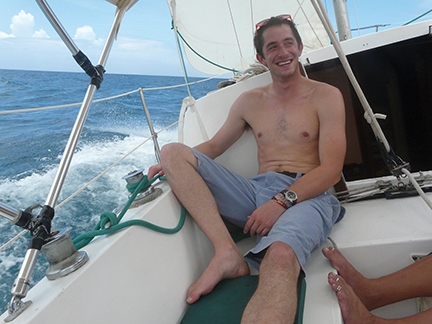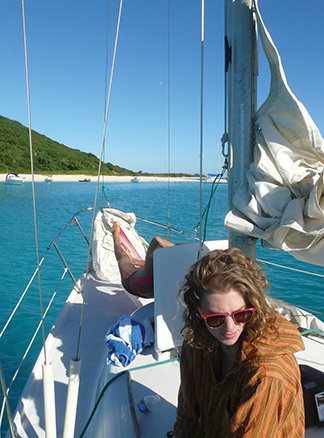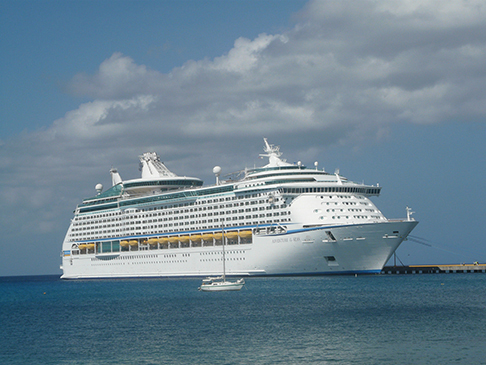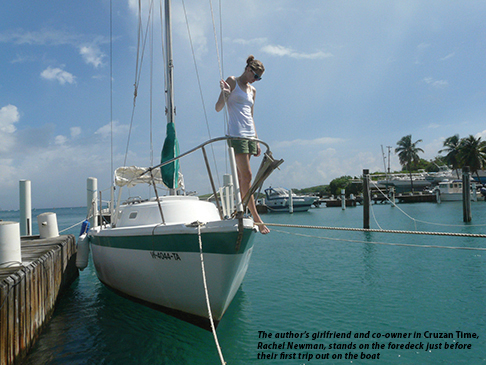How a cash-strapped 24-year old fulfilled a dream (published July 2013)
Most of my friends don’t own boats. At twenty-six, we generally have a hard enough time maintaining a car, paying rent, finding clean clothes, even showering regularly. So forget boats. As a demographic, we’re more likely to head to the bar than the marina, even if the marina does have a bar. Short on money, and money is definitely short, it usually gets doused in drink or any of the other passing interests that my self-obsessed generation drowns in. But does it have to be that way?
Limited cash flow shouldn’t stop you from anything other than buying a really expensive boat. Nor should something as simple as not knowing how to sail. It didn’t stop me. All you really need is the drive—or, if you prefer, the lift. The rest can be figured out easily enough.
That’s exactly how, as a cash-strapped twenty-four-year-old with almost no sailing experience, I became the proud owner of Cruzan Time, a Cal-27 in the U.S. Virgin Islands.

Okay, so I’m not the sole owner. And thank goodness, because that, admittedly, would have been foolhardy. I’m one of four owners. And therein lies the secret: find partners, the right partners.
KNOW WHAT YOU WANT
From the outset, before any action is taken, you should have a pretty clear idea of what you’re interested in. Do you want a small dinghy to zip around the harbor? A daysailer? A cruiser? Much of this is influenced by what you want to get out of it, which in turn, is dictated by where you live or where you’re going to berth the boat.
In my case, I was initially interested in more of a daysailer. I was thinking something light, manageable and easy to learn on that would enable me to make the short sail out to Buck Island off St. Croix. But I was open-minded.
When a 27-foot cruiser went on the market in our price range, I quickly thought through not only the additional costs and maintenance requirements, but also weighed the additional opportunities a boat like that opened up. An eight-hour crossing to the north, and we could be moored off St. John or in the British Virgin Islands, even off Vieques or Culebra. The cruiser began to look much more appealing.
First and foremost, I never would have considered it without the right people because I couldn’t have afforded it on my own. Secondly, I wouldn’t have known what the hell I was doing on a boat that size. If I was to get out sailing, I needed people, and not just anyone, but people who knew how to sail.
KNOW YOURSELF, KNOW YOUR PARTNERS
Partnering in a boat isn’t for everyone. I’ve heard horror stories about parties taking advantage of each other, not pulling their weight, failing to communicate, leaving the boat in disorder and arguing over who can use the boat when. It can be touch-and-go. And with all of the unexpected expenses inherent in boat-ownership, it can be a perilous misadventure under the wrong circumstance.
I met an Englishman in Costa Rica who hadn’t vetted his partner properly and was paying the price dearly. He had been eyeing a trip from the Mediterranean to the Galapagos Islands, a lifelong dream of his. He wanted a partner to tag along for the trip and also to cut the cost. An acquaintance of his expressed interest and my friend rather hastily found a boat, fixed it up and the two set out on their trip. But about a week into their Atlantic crossing the partnership turned foul.
The two quarreled constantly, mostly because the acquaintance turned out to be a royal pain in the aft and had lied about his finances, burdening my friend with almost all of the costs and throwing the trip into peril. By the time they made it to Panama, the Englishman had had enough and the two ended up selling the boat before ever seeing the sun set on the Pacific. He was not a happy man when I met him—don’t end up like him.
That public service announcement having been broadcast loud enough, partnering in a boat can also be ideal. Hauling out the boat for work and repair doesn’t look so daunting when split two, three or four ways. The key is to know yourself and know your partners. If you’re covetous, inconsiderate and never adequately learned to share in kindergarten, then co-ownership is probably not a good idea for you. You’ll only infuriate your partners to the brink of mutiny and they will probably force you to walk the plank, so to speak. Likewise, if the previous sentence describes your partner, then you would do best to keep looking.
Owning a boat in a partnership is a delicate dance though. You need to evenly juggle the costs, maintenance and usage, and you need to be able to do so in a civil manner. Which means you have to get along, be considerate and most importantly, trust each other.
Our partnership fell together beautifully and we haven’t looked back since. It consists of two couples, my girlfriend, Rachel, and me, and our friends Carsten and his wife Amanda. The setup worked beautifully, because while there were really only two parties, the costs were split four ways. It was simple and smooth.

Not long after getting to the island, I put feelers out. I grew up in Cincinnati, a place where boating prospects are limited to motoring along the polluted waters of the Ohio River. But for some reason I’d always dreamed of sailing. So, when a daily newspaper on St. Croix hired me, I knew that if there were ever a time to take up my unfulfilled passion, this was that time.
I got right to work. I went to the local yacht club, talked with a colleague who had partnered in a boat on St. Thomas, and basically pestered anyone I spoke with. Amanda worked at the newspaper too, and at least partially due to my persistence, I found out that she and Carsten had been on a never-ending search for the right boat, they just hadn’t found one in the right price range.
They had spent years on a 26-foot sloop, Stormy, in which they’d sailed up and down the East Coast, from Cape Cod to the Florida Keys. We were intrigued and they obviously knew what they were doing. We needed to learn. They were willing to teach us and we both needed to defray the costs somehow. More importantly, we all got along beautifully. And so, the search began.
KNOW WHAT YOU’RE GETTING INTO
Much to the dismay of many a naïve sailor, there is so much more to owning a boat than the time you spend out on the water. In all the emotion of imagining boat ownership, the day-to-day realities can easily get cast aside in grandiose visions of the wind filling the main and the spray of the sea. Those unrealistic people (people like me) need to be reminded of what is really on the horizon.
It is important for partnerships to outline and maintain clearly defined roles for everyone involved. How will the group pay dockage fees? How will it authorize purchases for the boat? How will each party be reimbursed? How will it deal with routine maintenance? And what about larger projects? Who will be responsible for checking and maintaining lines, for scrubbing the hull? And who can use the boat when?
All of these things should be considered in advance, if for no other reason than to make sure everyone is on the same page. Force the serious conversations. Make sure everyone involved is willing to put in and live up to the partnership’s expectations.
Once Cruzan Time came on the market, everything became much more real. There had been a few red herrings in the preceding month or two, boats that piqued our interest but were not right. But once we found Cruzan Time, we knew. So we sat down to discuss what the boat would need, what that would mean for each of us and whether we were committed, all well before casting off.

Carsten and Amanda told us of the tedious hours we would need to spend polishing, sanding, cleaning and scrubbing. We knew Cruzan Time would need a new headsail, and surely other surprises would come along the way. The time and money spent to buy this boat would only be the beginning. Were we ready for that?
This frank conversation was a deflation of exuberance that brought us back to an even keel. We had gotten ourselves so keyed-up and excited in searching for the boat. So when we found it, our spirits went sky high. And, yes, we were ready.
NOW QUIT THINKING ABOUT IT!
There are a million reasons to not buy a boat. Few of them are very convincing, at least not for me. My parents probably listed off at least half that many in a rather futile attempt to dissuade me from sinking what limited money I did have into a huge, floating mistake. Both are attorneys: smart and pragmatic. I tend to be neither. So what if I didn’t have much money? I had enough to make it work. I would be cash-strapped, but I would be cash-strapped on a boat, and I can’t think of a better place to be in that situation.
So what if I didn’t know what I was doing? I would learn, and I can’t think of a better time to learn. So what if I’m young, foolhardy, in over my head? I’ll just blame the foolhardy and in over my head on being young, and I can’t help that I’m young.
For all the money I’d sink into the boat, for all the time I’d spend, for all the uncertainly and added complications it introduced to my life, I knew one thing: I would never regret this experience. And I haven’t.
I’ve learned so much, and not just about sailing. I learned about myself, my character and what I didn’t like, I changed. I learned to deal with others better, to communicate, to hold up my end of a bargain for no other reason than saying I would.
A lot of people recommend a legally binding contract. We talked about it and planned to draw something up. Only, when the owner accepted our offer, we lost ourselves in the excitement. We bought the boat without another thought. We’d already done the hard thinking. We said we would draw up papers in the following months, terms for all the legal stuff. But we never did (another decision my attorney parents scolded me for). That could have come back to bite us, but it didn’t. We were comfortable in the partnership and trusted each other to do the right thing. If we hadn’t been so confident in our partners, I think we would have written up a contract, but it just felt superfluous and, at least for me, a little dirty, like admitting from the start that you expected there to be problems.

With the right people, it’s probably not necessary. It hasn’t been for us. When it came time for each of us to write up a check, I didn’t hesitate. I wrote the figure and swore off half of my checking account with all the best intentions. That’s how, on September 18, 2010, at twenty-four, I became the proud owner of a Cal-27, along with my partners and friends. And I’ve never looked back. It was the best investment I’ve ever made.
Daniel Shea lived for two years on St. Croix, USVI, where he learned to sail. Recently, he moved to Denver, where he is restricted to murky ponds.
















